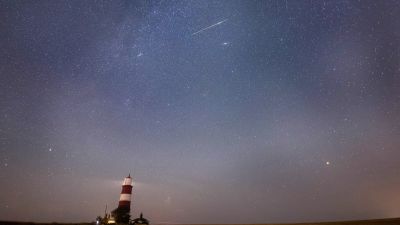Perseid meteor shower: What is it and is this the best year to see it?

The Perseid meteor shower has begun, with this year's display expected to peak during the waning of the moon creating perfect viewing conditions.
The shower will be visible in the night sky between July 17 and August 24 and will peak between August 12 and 13.
This coincides nearly perfectly with the darkest phase of the moon, which will be a thin crescent during the peak - reducing one of the biggest light pollutants in the night sky.Here's everything you need to know about the Perseid meteor shower.
What is the Perseid meteor shower?
The Perseid meteor shower is caused by debris falling from the tail of Comet Swift-Tuttle when it comes into contact with the Earth’s atmosphere. The comet orbits the Sun every 133 years.
The meteors, mostly no bigger than a grain of sand, burn up as they hit the atmosphere at 58 kilometres (36 miles) per second to produce a shooting stream of light in the sky.
Peak temperatures can reach anywhere from 1,648 to 5,537C (3,000 to 10,000 Fahrenheit) as they speed across the sky.
The meteors are called Perseids because they seem to dart out of the constellation Perseus every year.
Due to its radiance and regularity, the Perseid is among the most well-known meteor showers among stargazers.
When is the Perseid meteor shower hittings its peak?
In 2023, the Perseid meteor shower peak will be between July 17 and August 24.
It will peak between the night of August 12 and before dawn on August 13.
During the peak, observers should be able to see up to 100 meteors per hour.
Where is the best place to view the meteor shower?
During the shower's peak, there's a chance you'll be able to see it from anywhere in the UK.
But the best places will be areas with minimal light pollution and on a clear evening.
There are several International Dark Sky Parks in England and Wales which have been designated places of minimal light pollution and are ideal for stargazing.
Six national parks have been awarded International Dark Sky Reserve status, they are Exmoor, Brecon Beacons, Moore’s Reserve in the South Downs, Snowdonia, North York Moors and Yorkshire Dales.Northumberland has been noted to have the most pristine dark skies in England and has been designated an International Dark Sky Park.It also helps if the moon is in a crescent rather than full, to further reduce light pollution, which this year luckily occurs right at the peak in the middle of August.
Because of the radiance of the meteor shower, British observers should be able to see them at any time from when the sun sets until the sun begins to rise.
Want a quick and expert briefing on the biggest news stories? Listen to our latest podcasts to find out What You Need To Know...
The best hours will be from midnight till 5.30 am, according to the Royal Museums Greenwich.
You should also allow your eyes plenty of time to adapt to the night sky if you're trying to catch a glimpse of the meteors.
This means giving your eyes 30 minutes or so without any bright lights like car headlights and yes, your phone.